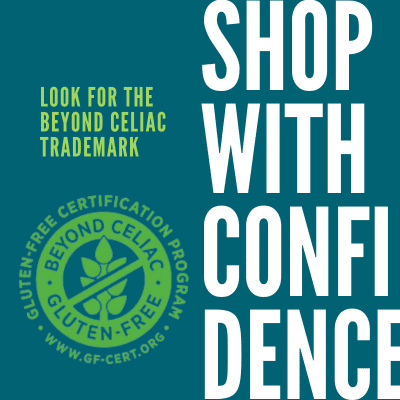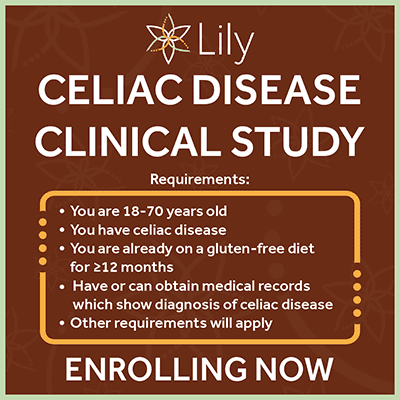01/12/2017
COLUMNS
HEALTH/WELLNESS
Renowned advocacy leader takes on celiac disease
Make progress your priority
When celiac disease symptoms happen outside the gut
When Celiac Disease Runs in the Family
Beyond Celiac volunteer and friend Sarena Snider shares her story
Getting Rid of the Anxiety
How to deal when you’re newly diagnosed
FOOD/LIFESTYLE
Facebook Fundraising
The easy way to support Beyond Celiac
GREAT Kitchens Closes 2016 in Buffalo
NEWS/UPDATES
Note from Alice
2017 is Our Year To Forge Pathways to a Cure!
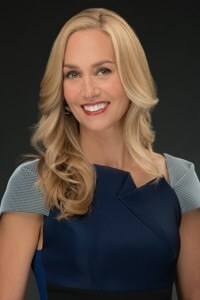 Whenever January rolls around, people immediately start talking about New Year’s Resolutions. The problem with resolutions, though, is that we tend to stray from them more often than not. That’s why I’m not making any resolutions this year. Instead, I am standing firm in looking at celiac disease through a different lens. And, my hope is that we can look at celiac disease through a different lens together.
Whenever January rolls around, people immediately start talking about New Year’s Resolutions. The problem with resolutions, though, is that we tend to stray from them more often than not. That’s why I’m not making any resolutions this year. Instead, I am standing firm in looking at celiac disease through a different lens. And, my hope is that we can look at celiac disease through a different lens together.
Allow me to explain.
When I was diagnosed over 20 years ago, my doctor told me to go gluten-free and sent me on my way. My “mystery illness” kept me in chains for nearly a decade prior to my diagnosis. The gluten-free diet was a godsend and my only lifeline. Did you have a similar experience?
I’ve talked about this before. How amazing I thought it was to be diagnosed with a disease that can be controlled through diet. However, we now know that the gluten-free diet is an effective solution only in theory.
When you put the gluten-free diet in the context of real life, we quickly realize just how difficult it can be to manage this treatment. Restaurants become off limits for many. Others of us skip parties altogether, or bring our own food, knowing it’s the only way to stay safe. It doesn’t sound too bad, until you realize that work trips become nearly impossible. Or you worry that your child’s teacher is going to forget about his needs. And there comes a time when you just don’t feel like talking about your autoimmune disease to your coworker, who isn’t quite sure what gluten is, but is avoiding it anyway.
Some of us manage just fine in our own homes. Others don’t even feel safe in our own kitchens because a 100% gluten-free household isn’t possible.
Staff members at Beyond Celiac talk about wondering if they really just have a headache, or if gluten is somehow sneaking in. It’s exhausting!
Even though I remain positive – I am extremely thankful to be diagnosed and no longer living with a mystery illness – I’ve promised myself that I’m no longer going to accept that this limited lifestyle is okay for me. At Beyond Celiac, we’re leading the charge toward a life without celiac disease. Over the past few years, you may have noticed that we at Beyond Celiac no longer look at the gluten-free diet as the cure for our disease. Frankly, the diet is simply a Band-Aid. We deserve better; we shouldn’t have to live with ongoing symptoms or fear or stress over food. We cannot simply avoid food. It’s an awful feeling to be afraid of what sustains us. We don’t even know what it is like to “be normal.”
Research is also fueling our feelings on the gluten-free diet. Science confirms what our community has told us all along: that we are still being exposed to gluten despite our best efforts to keep it out of our diets. It is not enough to keep us healthy and protected from the long-term health risks associated with continued gluten exposure. We need options.
For all of these reasons, I am not creating a New Year’s Resolution, but instead, I’m standing firm in my resolve to work with our community and researchers to give people with celiac disease the options we need. The goal of finding better treatment options, and ultimately a cure, will be the driving force behind the work of Beyond Celiac until we make it happen. Until then, our New Year’s Resolutions will never change; we’ll continue to lead our community because together we can change the future. 2017 is the year to make headway in achieving a better life with celiac disease.
To living better, longer,
Alice Bast
Beyond Celiac CEO
Cooking with Oonagh
January 2017 marks the sixth year I have written a monthly recipe column for Beyond Celiac, originally the National Foundation for Celiac Awareness (NFCA). I’ve only missed one month in that time, due to unexpected surgery. That’s a lot of recipes. I’d say they range from kid-friendly to Grandma’s comfort food to indulgent gourmet dishes. Enjoy two more recipes from me!
Vegetable and Quinoa Stir Fry
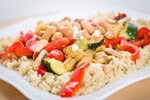 This is one of our favorite dishes. It’s great for meatless Mondays, vegetarians and using whatever combinations of vegetables and seasonings you want. We’re not vegetarians, but thankfully both my husband and son happily eat many vegetables, and most of the time we use meat as the seasoning in the Mediterranean way. Start the New Year off with some healthier, tasty meals like this one.
This is one of our favorite dishes. It’s great for meatless Mondays, vegetarians and using whatever combinations of vegetables and seasonings you want. We’re not vegetarians, but thankfully both my husband and son happily eat many vegetables, and most of the time we use meat as the seasoning in the Mediterranean way. Start the New Year off with some healthier, tasty meals like this one.
Watch the clip of me making this dish on New Hampshire’s ABC WMUR TV on my Facebook page.
Almond and Soft Toffee Cake
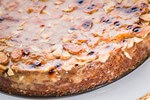 The cake part is a recipe I have made for many years as my raspberry almond tart, and is one of my son’s favorites, so it was almost the first recipe I adapted to be gluten-free. I can still eat butter, but my son and cousin and many of you are dairy-free. I have been using more and more coconut oil as a butter substitute and prefer it. Plus, even if you can eat butter, coconut oil is a cholesterol-free alternative. The only annoying thing about coconut oil is it comes in a jar and is rock hard unless you have a very warm house. I got fed up trying to dig out hard coconut oil, so now I slowly melt the coconut oil and transfer it into a large square tub with lid, lined with foil. Once it hardens I flipped it out and roughly cut it up into smaller pieces. Then, I weigh it when I use it, but store it in the square tub. I also just melt the coconut oil for this recipe. It is very difficult to get coconut oil evenly soft for beating with sugar, and I find it works by melting it. This cake is very dense and moist like a pound cake. The topping is also a good dairy-free caramel sauce for other desserts. It does taste a bit coconut-y and slightly oilier than butter, but still yummy.
The cake part is a recipe I have made for many years as my raspberry almond tart, and is one of my son’s favorites, so it was almost the first recipe I adapted to be gluten-free. I can still eat butter, but my son and cousin and many of you are dairy-free. I have been using more and more coconut oil as a butter substitute and prefer it. Plus, even if you can eat butter, coconut oil is a cholesterol-free alternative. The only annoying thing about coconut oil is it comes in a jar and is rock hard unless you have a very warm house. I got fed up trying to dig out hard coconut oil, so now I slowly melt the coconut oil and transfer it into a large square tub with lid, lined with foil. Once it hardens I flipped it out and roughly cut it up into smaller pieces. Then, I weigh it when I use it, but store it in the square tub. I also just melt the coconut oil for this recipe. It is very difficult to get coconut oil evenly soft for beating with sugar, and I find it works by melting it. This cake is very dense and moist like a pound cake. The topping is also a good dairy-free caramel sauce for other desserts. It does taste a bit coconut-y and slightly oilier than butter, but still yummy.
About Chef Oonagh Williams
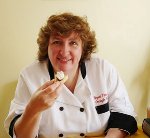 Chef Oonagh Williams has a culinary arts degree, celiac disease and other food allergies. She spends her time speaking and writing nationally on food for gluten-free and other food allergy diets, as well as offering cooking classes, dinner parties and one-on-one help. Locally, she teaches healthier food cooking classes for everyone, as most real food is naturally gluten-free and free of many other allergens.
Chef Oonagh Williams has a culinary arts degree, celiac disease and other food allergies. She spends her time speaking and writing nationally on food for gluten-free and other food allergy diets, as well as offering cooking classes, dinner parties and one-on-one help. Locally, she teaches healthier food cooking classes for everyone, as most real food is naturally gluten-free and free of many other allergens.
Chef Oonagh will be teaching a six-hour gluten-free baking class at a Culinary Arts College in Maine in March, plus various cooking classes in Boston, MA in the upcoming months.
Like her at Gluten Free Cooking with Oonagh on Facebook, where she posts recipes, links to her New Hampshire ABC appearances and products she’s found and tasted. Connect with her on Skype for help in following a food allergy or gluten-free diet.
Groundbreaking Advocacy Leader Joins Beyond Celiac Board
By Amy Ratner, Beyond Celiac Medical and Science News Analyst
.jpg) For many in the celiac disease community, Robert J. Beall, Ph.D. is a new name and face as he joins the Beyond Celiac Board of Directors.
For many in the celiac disease community, Robert J. Beall, Ph.D. is a new name and face as he joins the Beyond Celiac Board of Directors.
But he is familiar to Abby Schwartz, the mother of a 20-year-old daughter who has both celiac disease and cystic fibrosis.
Schwartz knows about all the work Dr. Beall did in his 35 years with the Cystic Fibrosis Foundation, where he was president and CEO for 21 years, before retiring in 2015. And she is excited about the role he will play in moving celiac disease forward.
“He was a dedicated and passionate leader who was visionary in how he approached research and treatment,” Schwartz says. “He took cystic fibrosis to groundbreaking places.”
Read about Dr. Beall’s extraordinary work in propelling research.
The Research Opt-In
.jpg)
Living with celiac disease is hard. Staying 100% gluten-free is a real challenge, especially when you’re not in control of the food. Even avoiding social scenarios where food is involved is a burden to your social life.
What if things could be different? What if you could walk into a restaurant and not have to put your medical history on the table? What if you could stop worrying and analyzing every little thing that goes near your (or your child’s) mouth? Imagine living without symptoms that never seem to fully resolve, even though you are strictly gluten-free.
Beyond Celiac is working with researchers to help accelerate more effective treatment options for celiac disease, with the ultimate goal of finding a cure. The trick is, the community has to be involved to make progress. Without you, researchers can’t reach their goals of helping you to live better, longer.
Getting involved is simple and easy. Just sign up for the Beyond Celiac Research Opt-In. You’ll get top research news delivered to your inbox either once a month or twice a month, depending on your preference. We’ll also send announcements about how you can get involved in specific research studies, whether that means taking a survey or volunteering for a drug study. There’s no obligation to participate in research just for signing up for the Opt-In.
Take control of celiac disease. Sign up for the Research Opt-In.
Allergic Living Sneak Peek: When Celiac Disease is Not All in the Gut
By Lisa Fitterman
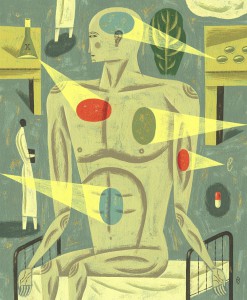 The fainting began in high school. Vanessa Oakley would be watching TV or studying – and then, she’d get to her feet and wake up on the floor. She would tell herself “I got up too fast,” or, “maybe I need to eat something.” She was too shy and reserved to ask for help and besides, there was never the foreboding sense that she was really sick.
The fainting began in high school. Vanessa Oakley would be watching TV or studying – and then, she’d get to her feet and wake up on the floor. She would tell herself “I got up too fast,” or, “maybe I need to eat something.” She was too shy and reserved to ask for help and besides, there was never the foreboding sense that she was really sick.
This was her normal: all the fainting, the sleepiness and having skin so translucent that the harsh fluorescent lighting at the discount department store where she worked following graduation highlighted her veins like a road map in blue. And if she had to miss a class or a shift at work, she would simply say to herself “Lots of other people do this, too.
Photo credit: ispot and Allergic Living
When Celiac Disease Runs in the Family

Photo Credit: WebMD
By Alice Bast, CEO, written for the WebMD Chronic Conditions blog
Once you have a celiac disease diagnosis, with its imperfect and incomplete treatment, thoughts of celiac disease are always as close as your next meal or snack. I know this all too well from my own personal experience, and I hear it again and again from others.
My friend Sarena Snider describes celiac disease as a cloud that is always around her, coloring the experiences of dining out, social events, her general perception of her health and how she thinks other people perceive her. As she told me in a recent conversation, “Celiac disease complicates things.”
When Sarena was 18, her father began losing a lot of weight with no apparent cause. Eventually, the culprit was discovered. After his celiac disease diagnosis, Ed became a staunch supporter of Beyond Celiac. We became great friends through our journey together. He was probably as aware as anyone of the genetic risk his children faced for celiac disease. Over the years, Sarena was tested, but came up negative.
Then, when she was 26, she had an unexpected weight gain. She had joint pain. A lot of joint pain. She had anxiety. And a physical and emotional malaise with no apparent cause. She became alarmed. She knew something was wrong and suspected celiac disease, but had to really push to get tested. After all, though weight fluctuations are common in celiac disease cases, weight gain is not a symptom that is quickly connected to it.
Finally, she got the answer that she had been suspecting: Celiac disease.
Alleviate the Anxieties of Being Newly Diagnosed with Celiac Disease

By Beyond Celiac Volunteer Julie Terrana of Best Whole Self
The New Year often brings about a sense of optimism, hope, and determination to make it “the best year yet!, ” but we have all also endured the same feeling the first New Year after being diagnosed with celiac disease or non-celiac gluten sensitivity (‘gluten sensitivity’): fear. There is great fear in the unknown; not knowing what to eat, what to do in social events, how it will affect relationships and if you will ever confidently be able to dine out without experiencing cross-contact.
#1. Be your own advocate
I often hear clients tell me that they occasionally eat gluten just because they do not want to be “an inconvenience” to those around them. While I completely understand how they feel, I remind them that it is critical that they be their own advocate and avoid gluten-containing foods at all costs. While dining out, be prepared to ask the waiter as many questions as necessary to ensure that your food does not contain any gluten. And, if necessary, ask to speak to the chef directly. If it makes you feel uneasy to do this in front of others, call the restaurant ahead of time to inquire about the menu (menus are often provided online, too) or show up a few minutes before the rest of your party to ask as many questions as you desire without feeling uncomfortable. Also, keep in mind that you are not a “burden” or “an inconvenience” to others because you are asking questions about what is in your food. As the popular saying goes, “those who mind don’t matter, and those who matter don’t mind.” Those who truly care about you do not want you to get sick.
While it is important to be your own advocate in order to ensure that you do not come in contact with gluten while dining out, it is equally important to be gracious while doing so. You do not have to apologize for being gluten-free, but be sure to show appreciation for the extra time taken to address your questions and concerns or to make menu adjustments that satisfy your request.
#2. BYOF—Bring Your Own Food
Living gluten-free means that food that is safe to eat will not always be available to you. Therefore, it is imperative to get used to bringing your own food, whether it be while traveling, at a work conference or at a holiday party. Almonds, Kind Bars, and a banana with almond butter to-go packs are perfect for traveling or to keep in your desk at work to stave off hunger when gluten-free food may not be easily available (it is also healthier, too!).
One of my favorite tricks is to offer to bring your favorite dish when visiting friends so that you know there is at least one thing that you can eat. When visiting friends at the beach in the summer, I often offer to bring ingredients to make sangria and fresh, homemade guacamole. There are plenty of naturally gluten-free foods that everyone would love to enjoy, too, such as bacon-wrapped scallops, hummus and veggies, grilled vegetable and cheese antipasto and potato salad, to name a few.
Also, feel free to bring a small amount of your own gluten-free food. For example, I always keep a box of dry gluten-free pasta in my car, so I know that if I go to a restaurant or a party where the main course is pasta, I can boil my own in a separate pot. (Restaurants will often boil your own pasta, too, but be sure they take the proper actions to avoid cross-contact.) Also, if I am attending a barbecue, I make sure to pack my own gluten-free rolls, or Bibb lettuce to make a bun for my burger. Trust me, no one will mind!
#3. Take the time to read labels
We know that gluten can be sneaky, and food labels are often confusing. However, a lot of times, it is our own haste that prevents us from eating safely. It takes less than 30 seconds to read a label. Regardless of how hungry you are, or how quickly you have to get through the grocery store, take a few seconds to read the labels. If you accidentally purchase something that is not safe, do not feel compelled to eat it. Donate it to a soup kitchen or give it to a friend if you feel guilty for throwing away perfectly good food. It is worth the extra time and money to be sure you are not glutened than to suffer the consequences for days–or even weeks–later.
#4. Find gluten-free brands you love
There are a few gluten-free brands to which I am loyal, for two reasons:
- I know that by purchasing my favorite brands, I always have good pasta, bread, and cereal.
- I know that I am always safe eating them.
As an Italian, I enjoy a good bowl of pasta. The thought of giving up my beloved carb left me feeling saddened after going gluten-free, until I discovered some amazing gluten-free pasta that honestly tastes like the “real” thing. My go-to brands are Barilla Gluten-Free Pasta, Ancient Harvest Quinoa Pasta, and if I am feeling a little more high-end, Gli Speciali gluten-free pasta that is found in Italian specialty stores. Additionally, Schar makes great gluten-free rolls and ciabatta bread, and Bob’s Red Mill is my go-to brand for almond, coconut, and all-purpose gluten-free flour. Bob’s Red Mill also makes a great gluten-free pancake mix, as well as rolled oats. I am confident that these brands produce great products that are also safe and free from cross-contact. So, do your own research or try some of my favorites so that you can live gluten-free without feeling deprived of your favorite foods.
#5. Educate those around you
How many times have you heard someone say, “Just have a little bit, it won’t hurt you,” when you decline something they offer that contains gluten? Unlike a diet to lose weight, we cannot simply “have a little” and then run it off, or sweat it out in a hot yoga class. Once the gluten enters our body, it stays there and wrecks havoc, no matter what we do afterwards. That said, it is important to educate those around us so that they know we cannot consume “just a little” gluten and what will happen if we do. The next time someone offers you something with gluten, or does not understand why you cannot eat a particular dish, simply tell them you appreciate the offer and while it sounds delicious, your body just cannot tolerate it and you will become very ill. If they truly care about you, they will respect your reply without feeling insulted. Additionally, you can send them interesting articles related to celiac disease and gluten sensitivity so that they feel like they are included in your life and journey living gluten-free.
About Julie Terrana of Best Whole Self
 Julie is a Certified Health and Wellness Coach in Philadelphia. She has been a volunteer for Beyond Celiac since 2013. Living with Crohn’s Disease, Julie has had a goal to reach remission since 2009. Despite trying numerous medications, she continued experiencing severe flares that led her to being hospitalized and eventually having surgery. In the summer of 2013, Julie went gluten-free and it changed her life. She has since experienced fewer flares and was able to run a half marathon in November 2013. Julie’s journey adjusting to a gluten-free diet has led her to develop a passion for helping others adapt to a similar lifestyle changes. She shows her clients that living with dietary restrictions does not have to be difficult and teaches them to navigate the obstacles of gluten-free living with ease and grace. Physical and emotional health are the main focal points in working with clients, which has led Julie to committing to her motto, “It is not about being skinny. It’s about being your best whole self.”
Julie is a Certified Health and Wellness Coach in Philadelphia. She has been a volunteer for Beyond Celiac since 2013. Living with Crohn’s Disease, Julie has had a goal to reach remission since 2009. Despite trying numerous medications, she continued experiencing severe flares that led her to being hospitalized and eventually having surgery. In the summer of 2013, Julie went gluten-free and it changed her life. She has since experienced fewer flares and was able to run a half marathon in November 2013. Julie’s journey adjusting to a gluten-free diet has led her to develop a passion for helping others adapt to a similar lifestyle changes. She shows her clients that living with dietary restrictions does not have to be difficult and teaches them to navigate the obstacles of gluten-free living with ease and grace. Physical and emotional health are the main focal points in working with clients, which has led Julie to committing to her motto, “It is not about being skinny. It’s about being your best whole self.”
Fundraising on Facebook
.jpg) Fundraising for Beyond Celiac is now easier than ever! Facebook has a built in fundraising app that lets you create your own online fundraiser to share with your friends and family in about five minutes. This option is great for kids looking to raise money for the organization, as part of a bar or bat mitzvah project, or for anyone who wants to help Beyond Celiac in our pursuit of better treatment options and an eventual cure for celiac disease. We are a 501(c)3 non-profit organization, and we rely on the donations of generous people to support our work that revolves around those following a medically-necessary gluten-free diet.
Fundraising for Beyond Celiac is now easier than ever! Facebook has a built in fundraising app that lets you create your own online fundraiser to share with your friends and family in about five minutes. This option is great for kids looking to raise money for the organization, as part of a bar or bat mitzvah project, or for anyone who wants to help Beyond Celiac in our pursuit of better treatment options and an eventual cure for celiac disease. We are a 501(c)3 non-profit organization, and we rely on the donations of generous people to support our work that revolves around those following a medically-necessary gluten-free diet.
Here’s how to do it:
- Log into Facebook on desktop or mobile. Head to www.facebook.com/fundraisers.
- The first option that appears with have a button that says “Create Fundraiser.” Click the button.
- Fill in the form that pops up. Give a brief description of why you’re asking for support for Beyond Celiac. Then, set a goal for how much you’d like to raise for Beyond Celiac.
- Share your fundraiser with your Facebook friends. That’s it!
Thank you in advance for your support of Beyond Celiac. If you’d like to make a donation directly to our organization, please visit www.BeyondCeliac.org/Donate.
GREAT Kitchens Closes Out 2016 in Buffalo
In December, Beckee Moreland, Beyond Celiac Director of GREAT Kitchens presented two educational sessions at Rich Products’ headquarters in Buffalo, NY. Rich Products Corporation, a valued longtime supporter of the GREAT Kitchens and GREAT Schools programs, is a leading supplier of quality dessert and baked goods products for foodservice, in-store bakeries and retail operations. They are also pioneers in the gluten-free segment, producing quality gluten-free muffins, cookies, brownies and pizza crusts that are served and sold in restaurants, schools, hospitals, airports and stores across the country.
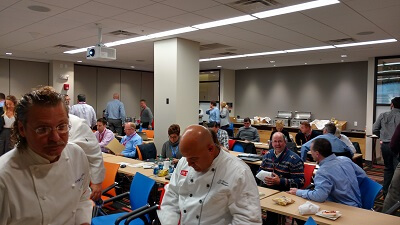
We’re so thankful that so many people came to learn how to
keep our community safe from gluten exposure!
The morning session included staff from Rich Products marketing and research & development teams, and the afternoon session included regional sales associates and culinarians. Much of the session content was gleaned from the GREAT Kitchens course focusing on understanding celiac disease as a serious, genetic autoimmune disease and the various needs of the gluten-free customer, sharing current gluten-free marketplace trends and statistics, discussing ingredient substitution and challenges, labeling and product certification, and sharing practical solutions for operators to maintain the safety and integrity of gluten-free products.
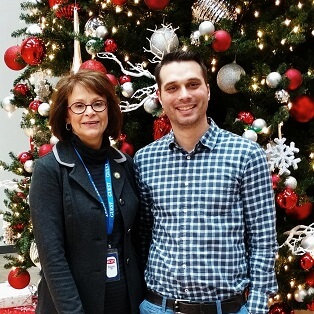
Beckee Moreland of Beyond Celiac with
Stuart Domanowski of Rich Products
Thanks to Stuart Domanowski from the Pizza & Flatbread Marketing team for organizing the visit and providing Beyond Celiac an opportunity to educate and advocate on behalf of the celiac disease community.
What’s Hot
In the Headlines:
-
Gluten-Free Watchdog Demonstrates Difficulty in Testing for Gluten Hot Spots Using Nima Sensor - Celiac Disease on “The Doctors”: Alice Bast of Beyond Celiac Shares the Truth about the Disease
On the Shelves:




